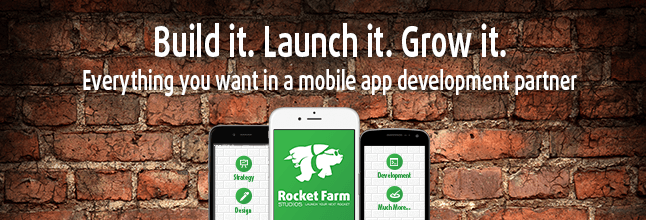After coming up with a strategy, user experience engineering and visual design are critical components to success in the mobile world. Don’t let a beautiful, easy to navigate mobile interface fool you – the design process is serious business. Using informed engineering decisions as a basis, our digital craftsmen reimagine the boundaries of what’s possible for user-driven, responsive mobile design.
Part 1: Engineering the ultimate user experience.
- Goal Identification – At Rocket Farm Studios, the design phase is all about trying to identify the core minimum loveable product (MLP) for release for the first experiment. To do so, we work with you in a workshop format with an essential motto in mind: we design and build applications to solve problems.
- Brainstorm – In order to solve problems we must first understand the needs of both app users and customers. We use our imaginations to develop user personas and give them a name, picture, and description to bring them to life.
- Storytelling – At the end of the day, it’s all about the user. To help us imagine an outcome, we pair user needs and personas to imagine a hypothetical situation concerning how a persona will pick up an app and use it to achieve success.
- Wire Framing – If you’re unfamiliar with the term, think of wire framing as the schema for an app flow. We create black and white renditions of functionality in order to detail each screen of the app.
- Screen Inventory – Next, we come up with a matrix of core features. To use the most relevant ideas, we constantly prioritize with the client to keep things at the MLP.
- System Requirements – Once we reach system requirements things start to get more technical in nature. This is when we start to think about the nitty gritty, like how to work in essentials like cache persistence, security, and log-in profiles for your mobile app.
Part 2: Designing the app of your eye.
- Brand Review – Sometimes startups don’t have an idea to begin with, and need some creative inspiration. To get the juices flowing we give you a bounty of ideas, you pick your favorite, and we run with it. By reviewing external apps, examining the subtleties of interaction and animation, and gauging your design goals, we want you to choose a visual style you like.
- Sound Check – Beep. Click. Swish. Those are just some of the sounds a user is used to hearing as he or she scrolls through an iPad, iPhone or Android application. Whether it’s the sound of a notification or simply the product of a completed action, sounds can add a unique dimension to the user’s experience.
- Market Preparation – If you haven’t already considered it, it’s time to get serious about figuring out what jet stream you’ll need to get behind your wings to launch your app into the app market.







